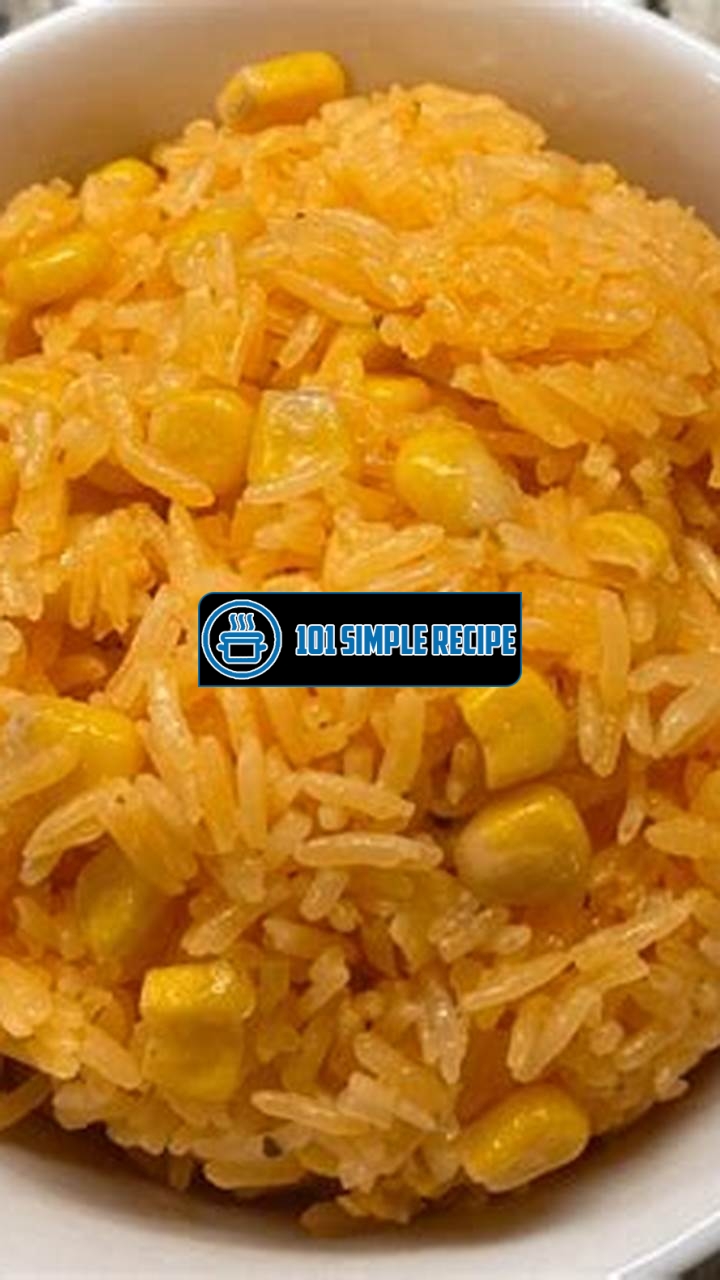Welcome to the ultimate guide on mastering the art of cooking yellow rice! In this article, we will take you on a culinary journey and show you how to create this vibrant and flavorful dish that will impress your family and friends. Yellow rice, also known as arroz amarillo or saffron rice, is a staple in many cuisines around the world, adding a burst of color and aromatic spices to any meal. Whether you are a beginner in the kitchen or an experienced cook looking to expand your repertoire, this step-by-step guide will equip you with valuable tips, techniques, and a delicious yellow rice recipe that will leave you craving for more. So, put on your chef’s hat and get ready to embark on a culinary adventure like never before!

The History and Popularity of Yellow Rice
Yellow rice, a flavorful and vibrant dish, has a rich history and is widely celebrated in various cuisines around the world. From its origins to its versatility, yellow rice has become a beloved addition to many meals.
1.1 The Origins of Yellow Rice
The origins of yellow rice can be traced back to ancient civilizations. It is believed to have originated in India, where it was known as “kesari” or “kesar chawal.” The vibrant yellow color was achieved by adding saffron, a prized spice in Indian cuisine.
This aromatic dish soon made its way to the Middle East and North Africa, where it became a staple in Persian, Arab, and Moroccan cuisines. Each region added its own unique twist, incorporating local ingredients and spices.
As trade routes expanded and explorers ventured across the globe, yellow rice made its way to the Americas and other parts of the world. It quickly became a favorite dish in Latin American and Caribbean cuisine, often referred to as “arroz amarillo” or “arroz con azafrán.”
1.2 Yellow Rice in Different Cultures
The cultural significance of yellow rice varies across different culinary traditions. In India, yellow rice is often served during festive occasions and religious ceremonies. It symbolizes prosperity, joy, and good fortune.
In Middle Eastern and North African cultures, yellow rice is commonly served alongside savory meats and stews. It adds vibrant color to the plate and complements the bold flavors of the region.
In Latin American and Caribbean cultures, yellow rice is a staple in everyday meals as well as celebratory feasts. It pairs perfectly with dishes such as roasted chicken, grilled fish, or spicy beans.
1.3 Yellow Rice as a Versatile Dish
One of the reasons for the widespread popularity of yellow rice is its versatility. It can be enjoyed as a main dish, a side dish, or a base for other ingredients.
Yellow rice can be cooked with various spices, such as turmeric, saffron, or annatto, resulting in different flavors and hues. It can be customized to suit individual preferences and dietary restrictions.
Whether it’s served alongside a flavorful curry, mixed with vegetables for a hearty stir-fry, or stuffed into peppers for a colorful twist on stuffed peppers, yellow rice adds both visual appeal and delicious taste to any meal.
Yellow rice is not just a dish; it’s a celebration of flavors and cultures coming together. Its history and popularity have made it a beloved culinary gem across the globe.
To master the art of cooking yellow rice, dive into its origins, explore its cultural significance, and savor its incredible versatility. Whether you’re adding a splash of vibrant color to your plate or experiencing the flavors of a different culture, yellow rice is sure to delight your taste buds and feed your soul.
For delicious and flavorful yellow rice, try this recipe from 101 Simple Recipe: White Castle Recipe.
2. The Key Ingredients for Cooking Yellow Rice
When it comes to cooking yellow rice, there are a few key ingredients that are essential in order to achieve the vibrant yellow color and flavorful taste that make this dish so special. By carefully selecting the right rice, using aromatic spices and herbs, and incorporating other colorful ingredients, you can master the art of cooking yellow rice like a pro.
2.1 The Importance of Rice Selection
The first and most crucial step in cooking yellow rice is selecting the right type of rice. For this dish, it is recommended to use long-grain rice, such as Basmati or Jasmine rice. These varieties have a distinct fragrant aroma and absorb flavors well, resulting in a more delicious yellow rice.
Additionally, opting for high-quality rice will greatly enhance the overall taste and texture of your dish. Look for rice that is well-milled and free from any impurities. This will ensure that your yellow rice cooks evenly and produces a fluffy and enticing final product.
2.2 Aromatic Spices and Herbs
The use of aromatic spices and herbs is another key element in achieving the authentic flavors of yellow rice. Some of the essential spices include turmeric, saffron, and cumin. These spices not only add a beautiful golden hue but also infuse the rice with a rich and earthy taste.
Begin by heating a small amount of oil in a pot and adding the spices. Allow them to release their flavors by gently toasting them for a minute or two. This process will help enhance their aromatic properties and ensure they are evenly distributed throughout the rice.
In addition to spices, fresh herbs such as parsley or cilantro can be added to provide a refreshing and vibrant taste. Finely chop the herbs and sprinkle them over the cooked rice just before serving. Not only does this add a pop of color, but it also adds a layer of freshness to the dish.
2.3 Other Colorful Ingredients
To make your yellow rice visually appealing, incorporating other colorful ingredients can make a significant difference. Vegetables like bell peppers, peas, or corn can add bursts of vibrant hues that complement the yellow tones of the rice.
Consider adding a handful of frozen peas or a diced bell pepper to the rice while it cooks. This not only brings more color to the dish but also adds a bit of texture and sweetness to each bite.
For those looking for an extra flavor boost, adding a small amount of broth or stock instead of plain water can elevate the taste of the rice. The liquid will absorb into the grains, enriching them with added depth and complexity.
Remember, the key to mastering yellow rice lies in the careful selection of ingredients. By choosing the right rice, using aromatic spices and herbs, and incorporating other colorful additions, you can create a dish that not only looks beautiful but also tantalizes the taste buds. So, get creative and experiment with different flavors to personalize your yellow rice recipe. Enjoy the process and savor each aromatic mouthful!
If you want to add a refreshing and fruity punch to your yellow rice dish, try this recipe from 101 Simple Recipe: Punch Bowl Recipe.
3. Preparing Yellow Rice: Traditional Methods vs. Modern Techniques
When it comes to preparing yellow rice, you have a choice between sticking to traditional cooking methods or embracing modern techniques. Each approach has its advantages and drawbacks, and it’s important to consider which one suits your needs best. In this section, we will explore the differences between the two and help you decide which method is right for you.
3.1 Traditional Cooking Methods
Traditional cooking methods for yellow rice involve using a stove and a pot. The ingredients typically include rice, turmeric, cinnamon, cloves, and sometimes saffron. These spices give the rice its characteristic yellow color and rich flavor. The rice is first rinsed to remove any excess starch, and then it is cooked in the pot with the spices and water. The process usually takes about 20-30 minutes, depending on the quantity of rice and the desired texture.
One of the benefits of using traditional methods is the ability to control the cooking process. You can adjust the amount of spices to suit your taste and experiment with different combinations. Additionally, the slow cooking method allows the flavors to blend together beautifully, resulting in a delicious and aromatic dish.
3.2 Modern Techniques and Time-Saving Tips
With the advancement of technology, modern techniques for cooking yellow rice have become popular. One of the most common methods is using a rice cooker. This appliance simplifies the cooking process by automatically adjusting the cooking time and temperature. All you need to do is add the ingredients, press a few buttons, and let the rice cooker do its magic.
Using a rice cooker offers several advantages. First, it saves time and effort as you don’t need to constantly monitor the rice or stir it. Second, it ensures consistent results every time, as the temperature and cooking time are controlled precisely. Lastly, it frees up space on your stove, allowing you to prepare other dishes simultaneously.
If you’re looking for even more time-saving tips, consider using pre-packaged yellow rice mixes. These come with pre-measured spices, making it convenient and quick to prepare a flavorful dish.
3.3 Pros and Cons of Each Approach
Both traditional cooking methods and modern techniques have their pros and cons. Traditional cooking allows for more customization and experimentation with flavors, while modern techniques offer convenience and precise results. It ultimately comes down to personal preference and the amount of time and effort you’re willing to invest in the cooking process.
For those who enjoy the art of cooking and want to savor the process, traditional methods may be the way to go. On the other hand, if you’re looking for a quick and foolproof way to prepare yellow rice, modern techniques such as using a rice cooker or pre-packaged mixes are great options.
No matter which approach you choose, mastering the art of cooking yellow rice is all about finding the method that suits your taste and lifestyle. So go ahead, experiment, and enjoy the delightful flavors of this vibrant dish!
4. Adding Flavors and Variations to Yellow Rice
When it comes to cooking yellow rice, the possibilities are endless. This versatile dish lends itself well to a diverse range of flavors and creative variations that can be incorporated to suit different taste preferences. Whether you want to infuse it with ethnic flavors, explore vegetarian and vegan options, or try out fusion recipes and creative twists, here are some ideas to master the art of cooking yellow rice:
4.1 Infusing Yellow Rice with Ethnic Flavors
If you’re looking to add an extra punch of flavor to your yellow rice, why not turn to ethnic cuisine for inspiration? By incorporating traditional spices and herbs from various cultural backgrounds, you can create a truly unique and tantalizing dish.
️ Spicy Fiesta: Give your yellow rice a Mexican twist by adding chili powder, cumin, and a hint of paprika. This will give it a fiery kick that will leave your taste buds dancing with delight.
Fragrant Indian Delight: Infuse your yellow rice with the exotic flavors of India by adding turmeric, cumin seeds, cardamom, and a touch of saffron. The aromatic blend of spices will transport you to the vibrant streets of Mumbai.
Asian Fusion: For an Asian-inspired twist, try adding soy sauce, ginger, garlic, and a dash of sesame oil to your yellow rice. This will result in a savory and aromatic dish that pairs well with stir-fried vegetables or your favorite Asian-inspired protein.
4.2 Vegetarian and Vegan Options
Yellow rice can easily be adapted to suit a vegetarian or vegan lifestyle. By substituting a few key ingredients, you can create a delicious and satisfying plant-based version of this classic dish.
Garden Fresh: Boost the nutritional value of your yellow rice by adding a colorful medley of vegetables such as bell peppers, peas, carrots, and corn. This will not only add texture and flavor but also make it a complete meal in itself.
Plant-Powered: Replace traditional animal-based proteins with plant-based alternatives such as tofu, tempeh, or chickpeas. These ingredients will provide a good source of protein and add a hearty and satisfying element to your yellow rice.
Creamy Coconut: For a tropical twist, substitute water with coconut milk to cook your yellow rice. This will add a rich and creamy texture and a subtle hint of coconut flavor that complements well with a range of vegetables and proteins.
4.3 Fusion Recipes and Creative Twists
If you enjoy experimenting in the kitchen, why not take yellow rice to the next level by incorporating fusion flavors and creative twists? These innovative combinations will impress your guests and keep your taste buds intrigued.
Taco-Inspired: Transform your yellow rice into a delicious filling for tacos by adding seasoned ground meat, black beans, diced tomatoes, and a dollop of guacamole. This fusion of Mexican and rice will be a hit at your next fiesta.
Rice Bowl Extravaganza: Create a vibrant rice bowl by topping your yellow rice with grilled chicken, mixed greens, avocado, cherry tomatoes, and a drizzle of tangy dressing. This fusion of flavors and textures will satisfy your cravings for a healthy and filling meal.
Seafood Surprise: Add a touch of elegance to your yellow rice by pairing it with succulent shrimp cooked in a flavorful garlic and butter sauce. This fusion of land and sea will transport you to the coastal regions of the world.
With these flavor-packed variations and creative twists, you can elevate the humble yellow rice into an extraordinary culinary experience. So go ahead, unleash your culinary creativity, and master the art of cooking yellow rice!
If you’re looking for a healthy option, check out this weight loss recipe from 101 Simple Recipe: Weight Loss Recipe.
5. Serving and Pairing Yellow Rice
When it comes to serving and pairing yellow rice, there are numerous options to choose from. By combining this versatile dish with complementary flavors, you can create a truly satisfying and well-rounded meal. Whether you prefer traditional pairings, incorporating yellow rice into main courses, or experimenting with fusion recipes, let your taste buds be your guide.
5.1 Traditional Pairings and Side Dishes
Traditional pairings and side dishes can enhance the flavors of yellow rice and create a balanced meal. Here are some popular options:
- Grilled or roasted chicken: The savory flavors of grilled or roasted chicken make it an excellent choice to accompany yellow rice. The tender meat pairs well with the aromatic spices of the rice.
- Black beans: Adding black beans to your yellow rice not only provides a boost of protein but also adds a rich and earthy flavor. It complements the vibrant color of the rice, creating a visually appealing dish.
- Plantains: Fried or baked plantains add a touch of sweetness to the meal. The contrast between the caramelized plantains and the savory yellow rice creates a delightful taste experience.
- Avocado: Sliced avocado can add creaminess and a fresh element to your plate. Its mild flavor pairs well with the boldness of the yellow rice.
By combining traditional pairings and side dishes, you can create a flavorful and satisfying meal that showcases the versatility of yellow rice.
5.2 Yellow Rice in Main Courses
While yellow rice is often served as a side dish, it can also take center stage in main courses. Here are a few ideas to inspire you:
- Yellow rice paella: This classic Spanish dish is a great way to showcase the flavors and colors of yellow rice. Combine it with seafood, chicken, and vegetables, and you have a hearty and delicious meal.
- Stuffed bell peppers: Fill bell peppers with a mixture of yellow rice, ground meat, and vegetables, then bake them until tender. This creative dish combines the flavors of yellow rice with the sweetness of bell peppers.
- Yellow rice stir-fry: Create a flavorful stir-fry by adding yellow rice to a hot wok with your choice of vegetables, protein, and sauces. The vibrant colors and aromatic spices will make this dish a hit.
By incorporating yellow rice into main courses, you can elevate it from a simple side dish to the star of the show.
5.3 Incorporating Yellow Rice into Fusion Recipes
If you’re looking to add a unique twist to your yellow rice, consider incorporating it into fusion recipes. By combining different culinary traditions, you can create exciting and innovative dishes. Here are a few ideas to get you started:
- Yellow rice sushi rolls: Use yellow rice instead of traditional sushi rice to create colorful and flavorful sushi rolls. Fill them with your favorite ingredients for a fusion twist.
- Spicy yellow rice tacos: Fill tortillas with yellow rice, spicy meat or beans, and fresh toppings like salsa, avocado, and lime. This fusion of Mexican and Caribbean flavors will leave your taste buds tingling.
- Yellow rice curry: Use yellow rice as a base for a fragrant curry. Add coconut milk, spices, and your choice of proteins and vegetables for a fusion dish that is both comforting and exotic.
By allowing yourself to be creative and adventurous, you can discover exciting ways to incorporate yellow rice into fusion recipes.
Remember, the key to mastering the art of cooking yellow rice is to experiment and have fun with different flavors and ingredients. Whether you prefer traditional pairings, main courses, or fusion recipes, the possibilities are endless. Get creative in the kitchen and enjoy the delicious results!
Thank you for taking the time to read our article on cooking yellow rice. We hope you found it informative and helpful in your culinary adventures. If you enjoyed this recipe and would like to explore more delicious dishes, be sure to bookmark our site and visit us again later. We regularly update our content with new recipes and cooking tips. Whether you’re a beginner or an experienced cook, we aim to provide you with the inspiration and knowledge to create amazing meals in your own kitchen. Happy cooking!
Frequently Asked Questions
Here are some frequently asked questions about cooking yellow rice:
| No. | Questions | Answers |
|---|---|---|
| 1. | What is the best type of rice to use for cooking yellow rice? | The best type of rice to use for cooking yellow rice is long-grain rice, such as jasmine or basmati. The grains are less sticky and will have a fluffy texture when cooked. |
| 2. | Can I use a rice cooker to make yellow rice? | Yes, you can use a rice cooker to make yellow rice. Simply follow the recipe instructions and set your rice cooker to the appropriate setting for cooking white rice. |
| 3. | Can I use turmeric powder instead of saffron to color the rice? | Yes, you can use turmeric powder instead of saffron to color the rice. However, keep in mind that saffron will provide a more authentic flavor and aroma. |
| 4. | How can I add more flavor to my yellow rice? | You can add more flavor to your yellow rice by incorporating ingredients such as onions, garlic, and spices like cumin and paprika. You can also add vegetables or protein, such as peas or diced chicken, to enhance the taste. |
| 5. | Is yellow rice a nutritious option? | Yellow rice can be a nutritious option when prepared with wholesome ingredients and served alongside balanced meals. It provides carbohydrates, some protein, and essential nutrients. |
| 6. | Can I store leftover yellow rice? | Yes, you can store leftover yellow rice in an airtight container in the refrigerator for up to 3-4 days. Make sure to reheat it thoroughly before consuming. |
Closing Thoughts
We hope you’re inspired to try cooking yellow rice after reading this article. It’s a flavorful and versatile dish that can accompany a wide range of main courses. Experiment with different spices and additions to make it your own. Remember, cooking is an art, so don’t be afraid to get creative in the kitchen. Enjoy the process and the delicious results!
Jump to Recipe
Cooking Yellow Rice

Learn how to cook aromatic and flavorful yellow rice at home. This simple recipe will guide you through the steps to achieve perfect yellow rice every time.
- 2 cups long-grain rice
- 1 tablespoon olive oil
- 1 small onion (finely chopped)
- 2 cloves garlic (minced)
- 1 teaspoon ground turmeric
- 1/2 teaspoon ground cumin
- 1/2 teaspoon paprika
- 4 cups chicken or vegetable broth
- Salt and pepper to taste
- Rinse the rice under cold water until the water runs clear. Drain and set aside.
- In a large saucepan, heat the olive oil over medium heat. Add the chopped onion and minced garlic. Sauté until the onion is translucent.
- Add the ground turmeric, cumin, and paprika to the saucepan, stirring to coat the onions and garlic. Cook for 1-2 minutes to enhance the flavors.
- Add the rinsed rice to the saucepan and stir well to combine with the onion and spice mixture. Cook for another 1-2 minutes to toast the rice slightly.
- Pour in the chicken or vegetable broth and season with salt and pepper to taste. Bring the mixture to a boil.
- Reduce the heat to low, cover the saucepan, and simmer for 15-20 minutes or until the rice is tender and the liquid is absorbed. Fluff the rice with a fork before serving.






